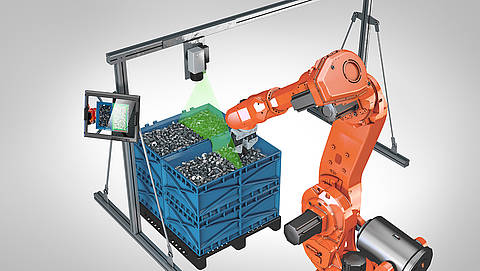
Bin Picking Automated object recognition and positioning
Recognize and remove
Robots perform increasingly complex tasks. Despite all the automation, there are still situations in modern-day production where it is more economical to load boxes or crates haphazardly than to invest time and manpower in loading them neatly. This, however, only shifts the problem from one end of the production line to the other. After all, you still need to unload the chaotically loaded objects and send them to the next station for processing. This takes manpower unless the work is done by singulators such as vibratory bowl feeders.
Interaction between Robots and Camera technology
BIN PICKING is a technology in which a robot, equipped with a 3D camera, takes parts out of a container filled with unorganized, often irregularly shaped pieces and aligns them properly before sending them to the next station. The challenge is to process differently shaped objects held in containers in an entirely random order.
Blumenbecker is a pioneer in this field, specializing in the development of sensor systems for industrial robots and the design of special gripping tools.
Your advantages
- Precision of part detection is +/-2mm with size of bin 1200x800x500. In case of smaller bin, precision is better, in case of larger bin its worse.
- Cycle time is 8-25 seconds. Cycle time will be shorter if we can pick part from bin and directly deliver part to another process. If it’s needed to grab part from another side or rescan part for better identification, cycle time will increase.
- One bin picking solution can handle more parts. Gripper of robot might be designed to handle more types of parts or gripper can be exchangeable.
- There could be also two bins with two robots under one longer camera portal. These robots could handle different parts.
- It’s possible to pick parts also from conveyor belts.
- Robot collision free trajectory is computed for entire robot path in advance.
Task areas of the robot application Bin Picking Bin Picking basically involves five tasks:
- OBJECT IDENTIFICATION– selecting the right measurement method, camera technology and resolution for different lighting conditions and component surfaces.
- OBJECT POSITIONS: Identifying the right algorithms for finding object positions in three dimensions.
- MOVEMENT: Identifying the right algorithms for finding object positions in three dimensions.
- GRIPPERS: Designing component-specific grippers.
- SOLUTION PACKAGE: Combining all these elements into one functioning robotunit.
Vendor-independent solutions from Blumenbecker
One challenge in BIN PICKING is that a vast amount of data must be processed in real time. For example, the robot must identify the part from a vast collection of 3D data. Then, a calculation method is needed to guide the robot axes and the gripper to the selected point. The robot axes can perform various movement sequences in order to reach the desired component. Some sequences, however, would result in a collision with the bin. Blumenbecker has developed a proprietary solution that, before starting a movement sequence, checks for collision hazards, calculates alternatives and then provides a corrected path for the robot system.
Blumenbecker supplies sensors and software supported by all types of robots, but also has its own design department to develop and build the required grippers.
